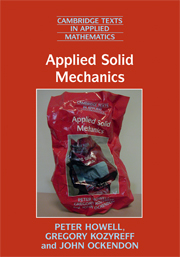Book contents
Nonlinear elasticity
Published online by Cambridge University Press: 02 February 2010
Summary
Introduction
In Chapters 2 and 3, we have analysed solutions of the steady and unsteady Navier equations, which were derived in Chapter 1 under the two assumptions that underpin linear elasticity.
First, we assumed that we could discard the nonlinear terms in the relation (1.4.5) between strain and displacement. Geometrically nonlinear elasticity concerns large deformations in which these terms are not negligible, so the strain is a nonlinear function of the displacement gradients. This inevitably leads to the further complication that the Lagrangian and Eulerian variables may no longer be approximated as equal.
The second assumption behind linear elasticity is that the stress is a linear function of the strain. This is a reasonable approximation for small strains, but it does not work well for materials such as rubber, which can suffer large strain and still remain elastic (see Treloar, 2005). Models for such materials require mechanically nonlinear elasticity, in which the stress is a nonlinear function of the strain.
As indicated in Section 1.6, the fundamental difficulty to be confronted is that the balance of stresses is performed in the deformed state, while the constitutive relation must be imposed relative to the reference configuration. As a first step in addressing this difficulty, we will revisit the concepts of stress and strain. We will show how they may both be expressed in a Lagrangian frame of reference, allowing a self-consistent constitutive law to be imposed between them. For mechanically nonlinear materials, such laws are far less easy to specify than (1.7.6), and we will see that great care has to be taken to avoid models that allow unphysical behaviour.
- Type
- Chapter
- Information
- Applied Solid Mechanics , pp. 215 - 244Publisher: Cambridge University PressPrint publication year: 2008

